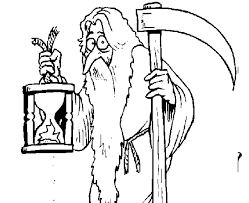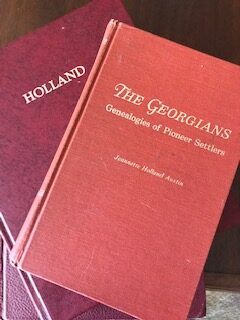Chattahoochee County Georgia Wills, Estates, Annual Returns, Appraisements, Inventories, Homesteads
Little Children Love and Need Story-Telling
Chattahoochee County was created in 1854 from Marion and Muscogee Counties. It was named for the Chattahoochee River.
Find your Ancestors in the Georgia Bible Records
Marriages
- Marriages 1854 to 1889
- (Index) 1854 to 1907
- (Index) 1866 to 1876
- Marriages from newspapers 1885 to 1886
Index to Probate Records
- Inventories, Appraisements, Sales, Homesteads, Book A (1863 to 1883)
- Inventories, Appraisements, Sales, Homesteads, Book B (1882 to 1940)
- Annual Returns, Book A (1854 to 1858)
- Annual Returns, Book B (1858 to 1860)
- Annual Returns, Book C (1860 to 1865)

Wills and Estates
- Wills (abstracts) 1853-1885
Military Records
- Confederate Rosters
- World War I Service Records
Tax Digets
- 1854
Traced Genealogies for Chattooga County Families
- Allgood
- Patrick
The Mutable Measuring Stick of Time
33-1/2 years makes a generation. In generations past, because of wars and disease, this was about the life expectancy of a person. In the 21st century, we enjoy good medicine and a better way. ” We have come a long way, baby.” Because the past was riveted with uncertainty, there are bundles of issues to consider while researching the family history. The researcher must consider the era in which he is working. Consider, up until about the 16th century, documents and old wills were written in Latin. Not only was the language different, but the elegant archaic script poses other problems. Although the dark (seldom fading) Indian ink written with a feather pen survives even to this day, it is not always possible to read the words or their meaning. Not without education in the past. When I was attending school, we were taught cursive writing, however, it did not contain the fancy looping effect that was employed fifty or a hundred years earlier. Although the era of Queen Victoria was during the late 19th century, most people are ignorant that there is a double-loop for (double “s”), and transcribe it as a “p” instead. Although I have read old records dating back to 1400, it is still necessary to employ visual aids. One essential aid is knowledge of the wording of legal documents, like deeds, wills, bonds, etc. If one knows that wording by heart, then it remains to work out the literal names such as the difference between capital letters and little letters in common names. Ancient writing styles (or early modern) are not taught in schools. In fact, I doubt if the average person can read the written word of the Victorian Age. Also, European children were taught Latin, English, and French. Before the coronation of King George, he only spoke German, thus, of necessity, he had to learn the English language! Yet, German immigrants populated America during the 17th and 18th centuries settling in German communities for obvious reasons, and there are old wills to be discovered, written in German, with an old-style flourish. So, how ignorant are we? Can we read the correspondence and documents of yesteryear? Or, do we procrastinate waiting for someone else to transcribe them for us? I have heard the rhetoric that Christopher Columbus raped tribal girls when he explored America. Yet, has anyone read his Journal? As it turns out, Columbus was deeply religious, and the journal in his own handwriting stated that he felt that God had sent him to find the New World. My question is this? How can such a brave explorer be judged by future reflections who had not or could not have read the explorer’s journal, written by his own hand in the Spanish language which went untranslated for hundreds of years?
Best Genealogy Website to find Georgia Ancestors - traced families, archived collections - Bible records, Cemetery, newspapers, births, deaths, old wills and estates, inventories, annual returns, vouchers, marriages, militia records, tax digests, obituaries

The Tally Stick in the First and Second Centuries
The tally stick was first a staff upon which the names of the contracting parties were written. Then, it was split down the middle, and one half (called the “stock”) was retained by one of the parties, while the other, “the bill”, was held by the other. When the time came to settle the contract, the two parties would present their halves of the stick to the king. If they matched perfectly, it was plain that neither party had attempted to tinker with the document, and all conditions having been met, the two halves were rejoined and bound with a string in the hand of the king – and stored in the archives. The oldest known tallies were written in Latin and Hebrew; found among the Dead Sea Scrolls in the Bar Kochba Cave; at least 23 samples are known as “tied deeds.


Ever Hear Tell of Silas John?
In the Bible, we read that the project of the Tower of Babel was discontinued because God changed the common language and the people could no longer communicate. Does one conclude that the people sat on their hands afterward and did nothing to write a new language? Then there is a 1904 article that appears in the journal Science. concerning a deeply religious Apache Indian by the name of Silas John who suddenly produced a highly sophisticated and perfectly functional system of writing. The Apache claimed that he had a single vision of it while dreaming. Although many writers in science journals deplore the way in which scientific conclusions were reached long ago, the story of Silas John reveals that man is creative and inventive. And that he prides himself in his accomplishments.
Analyzing Genealogical Findings for Results
Everyone who ever died did not prepare and file for probate a Last Will and Testament, yet even the poorest of families usually had an administrator appointed for a number of practical reasons. For one thing, they needed the authority to gain access to funds and to sell the property. For this reason, we must systematically research all the courthouse papers such as Annual Returns, Inventories, Distributions, Sales, Vouchers, and the Minute Books of Inferior Court. Because this is so important in locating relatives, whenever possible, I am adding the indexes to Annual Returns and estates for the various counties to GeorgiaPioneers.com. The first Annual Return for the estate generally pays doctor bills, funerals, and miscellaneous expenses of the administrator. Thereafter, in later returns, funds are dispersed to the heirs. You should really review these returns carefully and attempt to identify everyone receiving payment. Receipts are given to the administrator. You want to read the vouchers and receipts because this is where you will find the husbands of the daughters. Married women did not directly inherit; their husbands received the goods and signed for them. The Inventories and Sales contain the names of relatives and neighbors who were purchasing items. Also, this is where you will find a general description of parcels of land owned by the decedent and a list of notes owed him.

